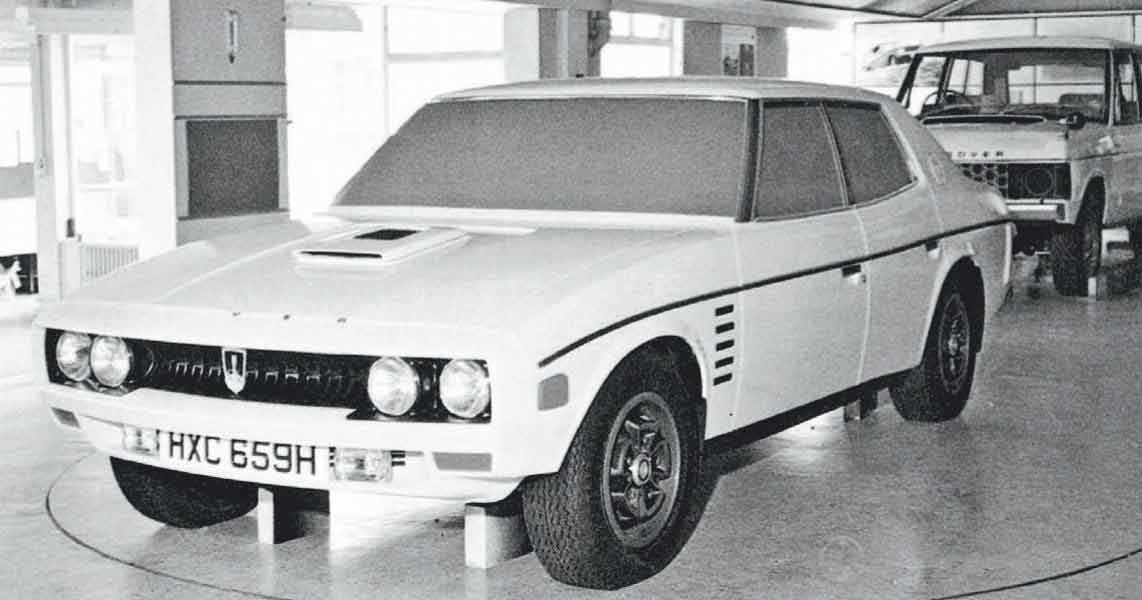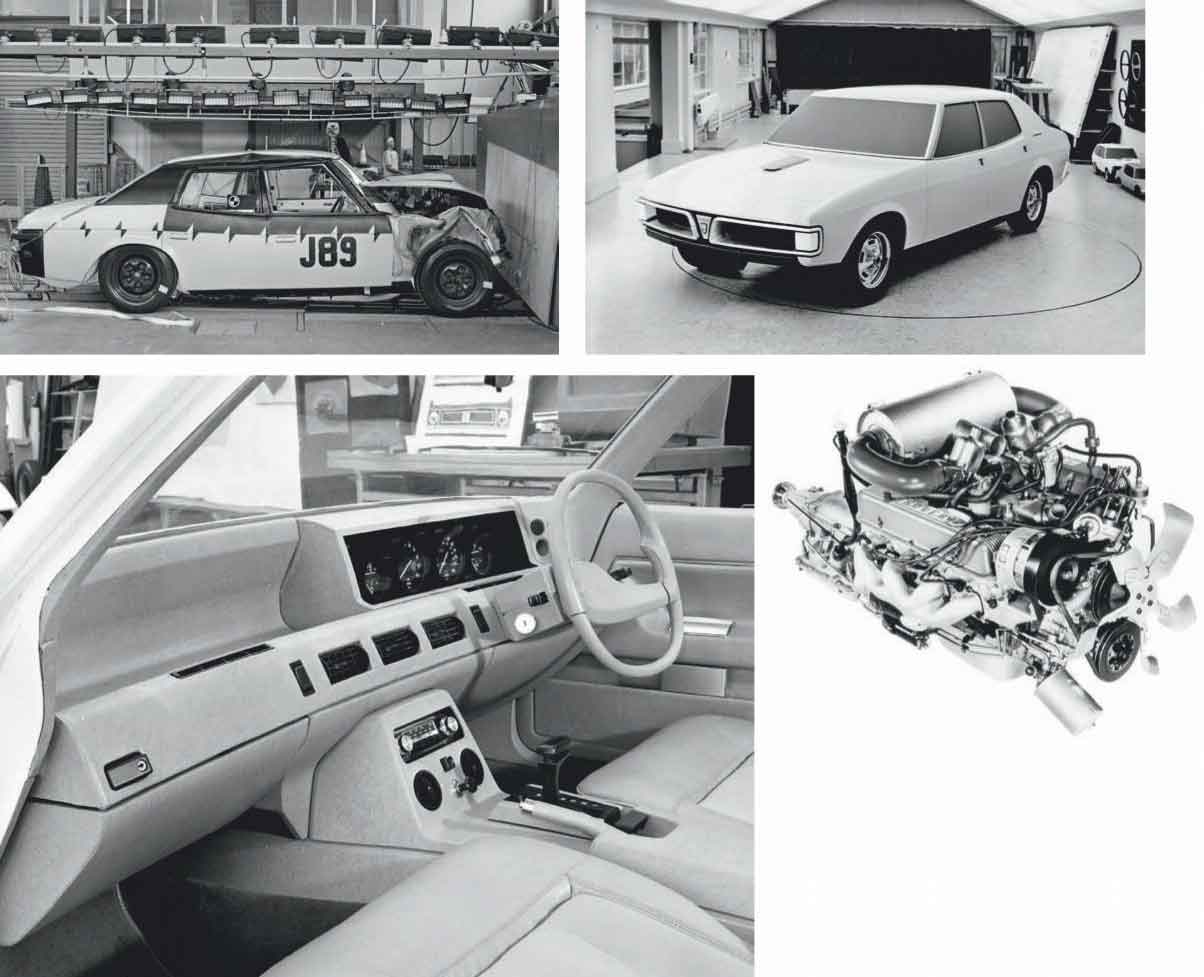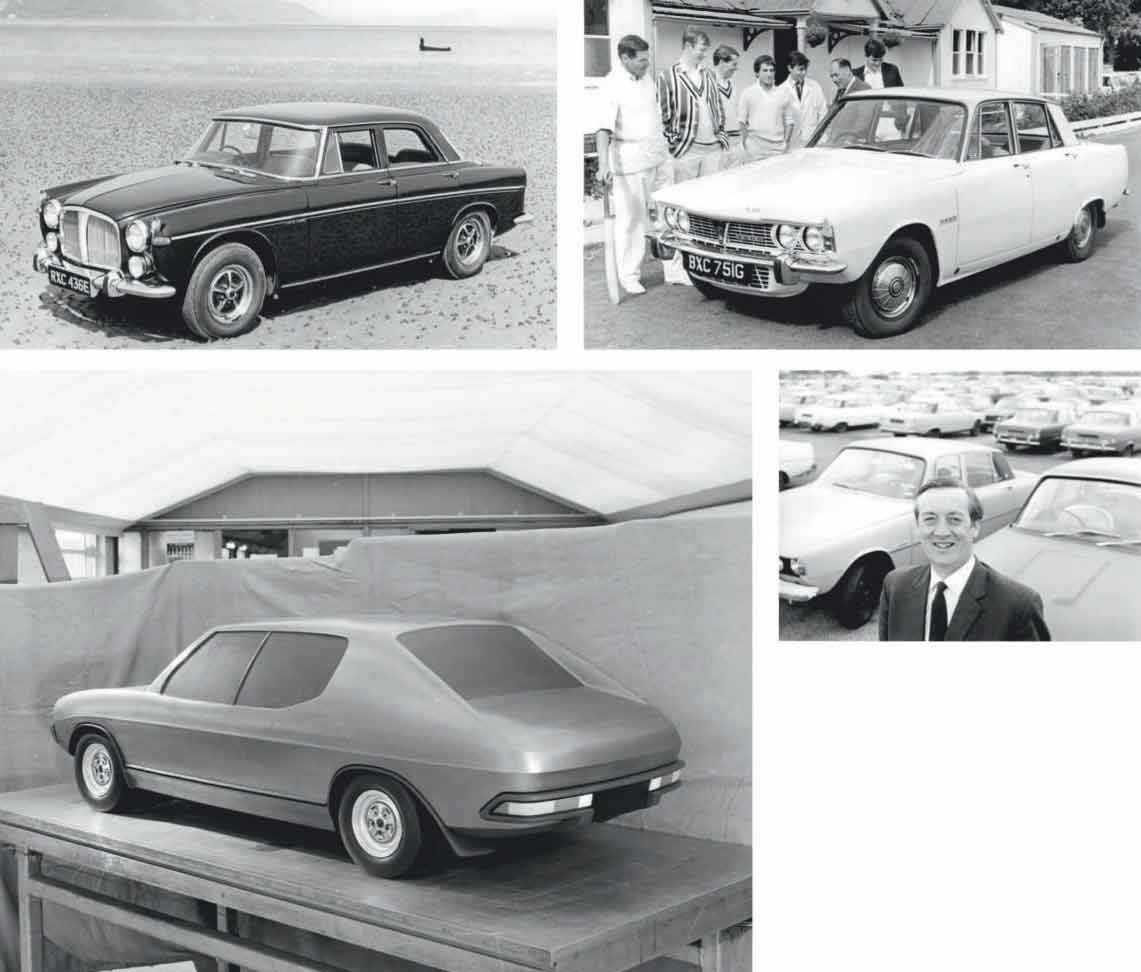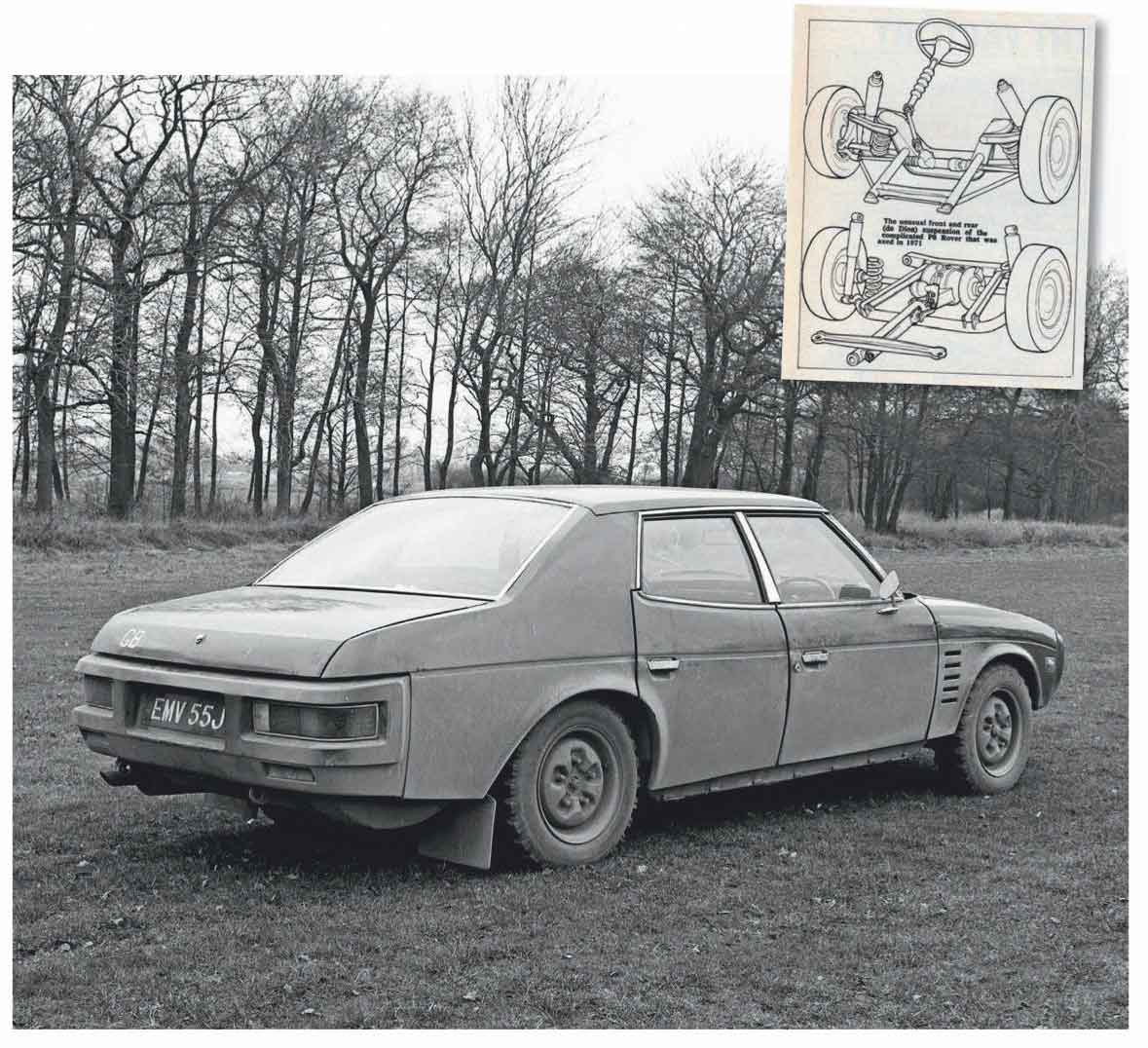It could have been the most advanced Rover, but the P8’s grand designs instead brought about its demise Words Jon Pressnell. Photography BMIHT/Author/Giles Chapman.
LAST TANGO IN SOLIHULL – THE FORGOTTEN ROVER
Jon Pressnell raids the archives to find out why the P8 project was cancelled
Where next? It was late 1967, and Rover seemed to have made up its mind. Its newest mainstream venture would be a single saloon to replace both the P6 2000 series and the P5B 3.5 Litre. But no sooner had the P8 project gained speed than it started heading for the wall, ultimately to fall victim to faulty decision-making, incoherent company politics and design failings. A one-car replacement made sense. Rover had a slender engineering team, and it was already working on the P6BS mid-engined sports car and the ‘100in Station Wagon’ that was to emerge in 1970 as the Range Rover. Plus, the P5 wasn’t a huge seller, and the axe almost fell on it to increase production of the in-demand P6.

Rover and Leyland had recently merged, but Triumph’s arrival as an in-house partner had no bearing on the P8 strategy; it was approved in December 1967 after a meeting with Sir Donald Stokes, head of the new combine, and Harry Webster and George Turnbull, his lieutenants. There was a buzz in the air at Solihull. Rover’s chief boffin, Spen King, had devised new suspension systems for the car, which was to have P6-like base-unit construction rather than be a classic monocoque. Meanwhile, exuberant styling chief David Bache toyed with the notion of gullwing doors, even purchasing and converting a Volvo 144 to top hinges, but the idea was soon abandoned. The engine was to be the ex-Buick V8, using both the existing 3.5-litre and an enlarged 4.4-litre unit. Power brakes were also part of the specification, drawing on Citroën practice and being intended to combat worries about fluid vaporisation when trying to slow a car of the P8’s weight.

‘Just a month after the engineers had returned from testing in Finland, Stokes decreed that the P8 was not to proceed’
With Bache’s team working up the body styling, King’s suspensions were trialled in three modified P6s. Coded P7A, P7B and P7C, the first two had just the new front suspension, while P7C also had the re-thought rear installation. “We were desperate to get the new suspension on the road to see how it performed,” said senior P8 development engineer Rex Marvin in 1996.
At the front, coil springs and twin wishbones were used, there being no need to retain the P6’s bell-crank horizontal-coil arrangement, originally designed to allow room for a gas-turbine engine. “The main principle was that there were two bars going fore and aft, joining the front of the structure to the toeboard area,” recalled Philip Mander, a project engineer on the P8.
“The suspension and the engine were on a subframe on flexible Teflon/rubber bushes that ran along this rail. The important thing with refinement is compliance, and the idea was to isolate the engine and the suspension with a very soft fore-and-aft rate while maintaining extremely rigid lateral and vertical control.”
At the rear was an evolution of the P6’s coil-sprung de Dion installation. This had a fixed-length rather than sliding tube, in conjunction with plunging variable-length driveshafts, and was mounted forward of the axle line rather than behind it to allow more boot space. Additional location was by diagonal radius arms.

“We felt the P6 was compromised by having the track-change effect of a sliding-tube de Dion,” Marvin explained. “It was also quite expensive, and there were occasional problems with the sliding of the tube – it was grunting. Plunging driveshafts worked fine.”
The sophistication of the rear suspension didn’t stop there, according to Marvin in an article for the P6 Rover Owners’ Club: ‘A major challenge arrived one day in the form of a pencil sketch by Spen King of an idea for rear suspension levelling using a single Boge Hydromat identical to that which had just been introduced on the low-pivot swing-axle Mercedes-Benz 300 and was later to be used on the Range Rover. Philip Mander managed to decipher the sketch – it was more than our pride was worth to go back to Spen for further clarification – and turn it into manufacturable parts. The system worked well, providing ride-height correction for increasing payload without adding roll stiffness.’
The self-levelling – energised via the power braking system – was very much part of the overall package, said P8 assistant project engineer Eric Branson: “Rex had some quite strong ideas on what you needed for a good ride. He wanted to make the suspension frequencies as low as possible, and you couldn’t do that and cope with variable loads. The corollary of the low-frequency ride was that you had to have some form of levelling.” It worked, reckoned Marvin: “P7C was a very fine-handling car, with low road noise, although I suppose it was fairly complex.”
Branson confirmed this verdict: “When it went round the pole at MIRA measuring lateral forces I think it was generating 0.83g, which was unheard of; most cars were generating 0.6g.”
If the new front and rear suspension systems were impressive, packaging them without eating into interior room was proving a challenge. This was a concern: the P8 was intended to have the same space as the P5. Technical director Peter Wilks reassured the board in April 1968: “A lot of ingenuity will be required, but I am certain that a satisfactory compromise can be reached.” Styling sign-off was delayed, with final approval only being given in September. “It was very high-waisted,” remembered Marvin. “That was a Dave Bache hallmark.” Philip Mander recalled “quite a macho car, brutal-looking”.
An innovative feature was the use of urethane bumpers; in the design studio Bache apparently had a Pontiac front bumper of the same material, which he delighted in hitting with a hammer to demonstrate its resilience. Pressed Steel Fisher, which would be tooling up for the new car’s body, was less convinced and drew up conventional steel bumpers, an initiative referred to by Wilks as a “funk hole” scheme. This, in retrospect, is the moment when the P8 went off the rails. Bache’s design had emerged as a bigger vehicle and the notion of a single model to replace both the P5 and the P6 looked unrealisable. Henceforth P8 was to be a replacement for just the P5 and a smaller design, P10, would be developed to take the place of the P6.

This change of direction might have been a result of the packaging requirements, which at the very least demanded a five-seat interior and a bigger boot than that of the P6. But there was something else at play, a desire – seemingly fuelled by Stokes – to produce a car to rival the bigger Mercedes-Benz models. “If you’re going to target them,” commented former Rover research engineer Mike Lewis, “you have to be prepared to cater for the German physique.”
Following the 1968 merger of Leyland and British Motor Holdings, there was now an in-house competitor, too, in the form of the Jaguar XJ6.
At this early stage, the slash-and-burn amalgamation of the once proudly independent specialist divisions of British Leyland was still being avoided. Consequently Jaguar’s arrival in the nest did not change the project’s orientation, and the XJ was in fact used as a development yardstick. “The P8 was a direct XJ6 competitor,” according to Marvin. “On road noise we were better. There was a fairly strong rivalry. The general feeling was that Rovers were bought by gentlemen and that Jaguars were bought by… others. There was still a belief that there was a place for Rover and for Jaguar. With hindsight, that seems a rather naïve way of carrying on.”
By summer 1970 the first P8 prototype had been built, and Wilks reported to the Rover board that first impressions were ‘exceptionally encouraging’. But there were signs that the project might be losing its way. “P8 was not controlled at all,” according to Eric Branson. “It was using fairly complicated engineering solutions to produce a very refined car. They’d got the 4.4-litre V8 in mind, so things such as the transmission were designed to cope with the additional power and torque of this bigger engine. People were always erring on the conservative side, so a lot of the componentry was really quite massive.
“For example, instead of balljoints we had taper-roller-bearing kingpins. They were beautiful and did a lot of good things, such as lowering steering friction, but were tremendously heavy. Whereas the P7s were typically around 3000lb unladen, the P8 was nearer 3500lb. I got a bit hot under the collar about this. I imagined the P8 would be a refinement of the P7s, so it was a disappointment when we realised it was rather bigger. It would have been a good package to hand over to Rolls-Royce.”
Meanwhile, production was scheduled to start in November of 1971 ahead of going on sale in ’1972. The crunch – literally – came in December 1970, when the P8 was put through the 30mph crash test, as Marvin recounted in 1996: “The car was already in trouble structurally. Its pavé performance wasn’t very good, in spite of its good suspension, and the body structure was suffering. In the first 30mph barrier test it performed very badly indeed.
“I’m not saying that it necessarily failed the rather limited criteria for steering-wheel intrusion, but the intrusion was fairly high and the overall appearance of the car after the test was much worse than the P6 – which hadn’t been designed for the test and by sheer good fortune had done well. The P6’s front suspension was designed the way it was for completely different reasons, but it worked out to be very safe.” Branson confirmed the problem: “The assembly was very stiff, so the subframe didn’t collapse, but it was so stiff the front end didn’t collapse at all. The loads went into the body and the body collapsed around the windscreen area.”
For Marvin, the result was mortifying but it could have been resolved. Lewis, who passed away in 2012, was less convinced: “It was a big problem and we were going the wrong way. An awful lot of engineering effort would be needed to be put into the car to hold it together.”
This was the reality check. In March 1971, just a month after the engineers had returned from testing the car in Finland, Stokes decreed that the P8 was not to proceed to production. Tooling had either been already completed or was sufficiently far down the line that there would be substantial cancellation charges. Rover boardroom minutes record that the decision had been made, ‘With the full knowledge of all the effects cancellation would have on the utilisation of our resources, the abortive expenditure which would have to be written off, and the extent to which the Company’s profits would be affected in the next five years.’ The total cost to Rover is said to have been £4m – a huge sum for the time.
Under pressure from Jaguar’s Sir William Lyons, but also because of British Leyland’s deteriorating finances, sanity eventually prevailed. Rover would start again with a simpler design – which became the SD1 – that would replace the P6 and the big six-cylinder Triumphs without competing with Jaguar. In retrospect the fate of the P8 had been inevitable, according to Lewis: “Here was the funny old Rover company proposing to make a car to compare with Mercedes-Benz, and to produce it cheaper than a Jaguar. It was an obvious dilemma – so obvious that I don’t know why we went on with it, let alone committing to tooling.
“I wasn’t wildly sorry to see it go, largely because it was such a great monster. It was running counter to the philosophy that we were starting to develop by then of ‘refined simplicity’. The P8 was the most technically advanced car we’d set out to do. But the market was turning around and saying, ‘We’re not certain we like complexity, because complexity and not working properly tend to go hand in hand.’”
The late Spen King – who had not been directly involved with the P8, following his promotion in 1968 to Rover-Triumph’s chief engineer – was another figure not enamoured of the car: “I hated the P8 for being as big as it was – I thought it unnecessarily so, and not what the company should have been making.”
Even Marvin, closer to the P8 than most, could see the sense in Stokes’ decision: “I didn’t want to see the P8 dropped. I thought we were going to have a very refined, good-handling car with up-to-date features. But there were considerable engineering doubts about the car. Many people were relieved when it was canned.”
The sadness, though, was palpable. “The P8 really had what we thought was the best of everything,” sighed former Rover managing director AB Smith when we talked in 1996. “It was probably one of the best cars we would have ever produced. All the lessons we’d learnt up until that time, both technically and in design, had gone into the P8.”





